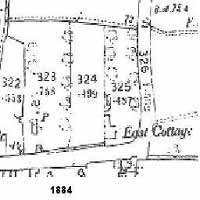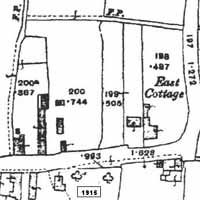![]()
29 Long Acre East Sometime known as Oak Villa
Summary
29 Long Acre East is a neat double-fronted Edwardian Villa built in 1910 for an insurance agent, Henry Thompson, as evidenced by the stone on the west gable wall bearing both date and initials. The land had formed part of an ancient pasture called Parr’s Close, part of which had been used to build East Cottage next door some thirty years earlier. The parcel of land on which Oak Villa stands was sold at the same time as the land for East Cottage but seems not to have been built upon then. It was not, as might first be imagined from the position of the house, sold off from East Cottage. It remained in the Thompson family until 1966.
Review of deeds, directory and census information
Deduction is the name of the game researching 29 Long Acre East! The house has a builder’s stone in the west gable wall with the date 1910 and initials HT carved on it. Documents for East Cottage next door, reveal the true history of ownership of the land and we have to deduce some of the later history!
In April 1810 a William Chettle, farmer and grazier of Thornley, Cambridgeshire inherited a piece of land called Parr’s Close from John Chettle, grazier of Bingham. Chettle’s son, known as William Chettle Senior, a farmer of Bingham, had inherited the close at some point and possibly around 2nd January 1837 (the first deed document available for East Cottage) sold part of the close to William Sills.
The first document in the deed bundle for number 29 is dated 28 April 1921, by which time the house had existed for over ten years. That document records the sale for £90 of a piece of freehold of land in Bingham. A bricklayer named Arthur Victor Clipstone, formerly of Bingham but then of Rotherham, sold the land to Henry Thompson, Insurance Agent – so here we have our HT for whom Clipstone probably built the house.
One’s first impression is that the house stands on land split off from East Cottage after the latter was built. When you look at the actual properties it seems a reasonable assumption, but it is not what happened! Clipstone may have bought the whole plot from Swanwick intending to build two houses. In the event he built only one house on half the plot and sold the land and the house we assume he built to Thompson. He presumably retained the other half of the plot, which he sold to Thompson in 1921 restoring the Oak Villa plot back to its former size. The documents for this initial purchase are missing.
The schedule describing the piece of land sold in 1921 is reproduced in full below and it requires careful reading – our interpretation is in small italics:-
Piece of land in Long Acre containing
one rood (a quarter of an acre – 1210 square yards)
being half of a larger piece of land containing two roods
(formerly said to contain two roods one perch and said to
have been at the south west corner (this looks very much like
but is not the land of East Cottage, the area noted in those
deeds, is two roods and two perches) of and forming part of
a field called Parr’s Close) and which piece of land
now being described is bounded
westwardly by land belonging
to the Earl of Carnarvon and formerly occupied by one Robert
Green and now by his grandson Robert Green (This is a piece
of land east of and then part of Donkey Green’s Cottage,
now number 25)
southwards by Long Acre (note not yet called
Long Acre East) to which it has a frontage of 41 feet or thereabouts
eastwardly by the remaining half of the said
larger piece of land as sometime conveyed by William Harold
Swanwick (the land forming East Cottage was sold to George
Shepherd. Swanwick’s predecessor, William Sills, bought
the piece next to it. Thus the plot forming the eastern boundary
described here is the eastern part of the two rood plot sold
to Sills at the same time as the East Cottage plot was sold
to Shepherd) Thus this land is actually west of Oak Villa,
was half of the land originally bought by the builder Clipstone
and is being purchased to add to the existing plot. Thus the
original plot is restored!)
and northwards by a public footpath on a
close of land belonging to the Earl of Carnarvon and now occupied
by Luke Stafford
and the same piece of land now being described was formerly
in the occupation of said W H Swanwick and now in that of
Henry Clarke.
 |
The succession of OS
maps shows how Swanwick’s plot was divided. 1883
shows East Cottage as parcel number 325 and measuring
.487 acres. Parcel 324 next door is .499 acres, virtually
the same size as East Cottage. Parcel 324 is next door
to Donkey Green Cottage, confirming the original land
description. By 1915 parcel 324 (now 199) has been split
into two, measuring in total .505 acres. The eastern portion
shows Oak Villa, the western portion has no development. Henry Thompson died in 1940 and the house passed to his son. The Assent, dated 17 January 1941, granted to Charles Henry Thompson actually deals with three distinct entities making up the property: |
 |
1 land as previously described but bounded towards the east by hereditaments now of Misses Ann Bolton and Alice Maud Bolton (see East Cottage for how they inherited) and on the west by land hereinafter secondly described (2 below) (eastern portion of the original plot)
2 dwelling house “Oak Villa” erected on the land (described in 1) together with outbuildings etc
3 all that piece of land situate and having a frontage of 41 feet to Long Acre Bingham hereinafter described (the deed repeats the description given in the 1921 deed) and containing one rood bounded northwards by a footpath etc (western part of the original plot)
The third entity is the piece purchased in 1921 (the other half of the original plot) and indeed more recently was sold off to build number 27 Long Acre!
C H Thompson sold the property to Anthony Shipman of 29 Carnarvon place in 1966 for £2600. In 1941 he sold a 240 square yard plot in the North east corner to Mr Hinde, a neighbour to extend his garden. In 1978 Shipman sold to the present owners.
